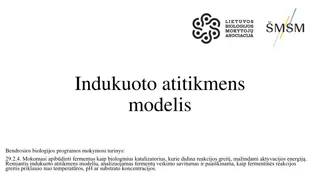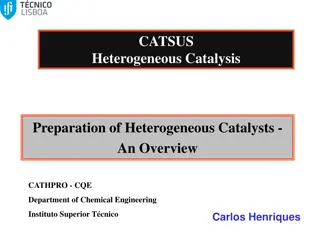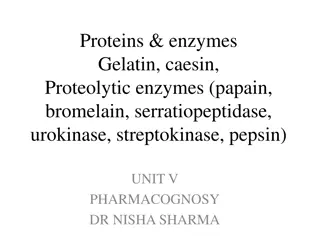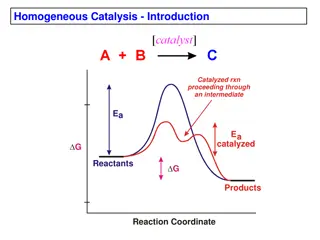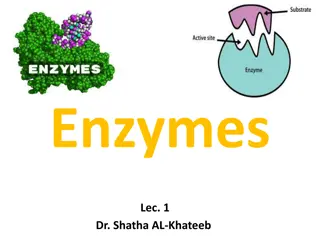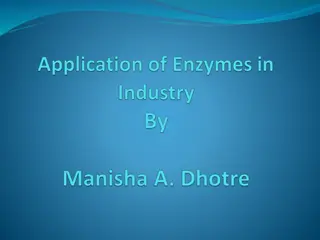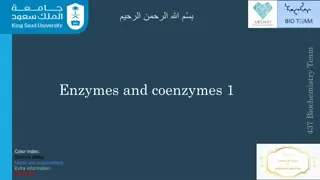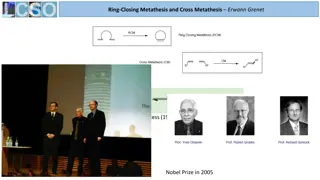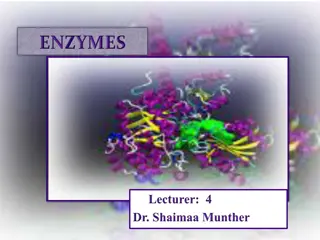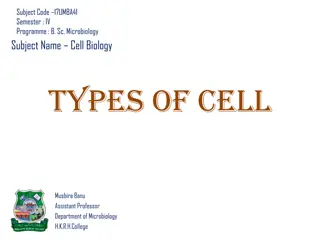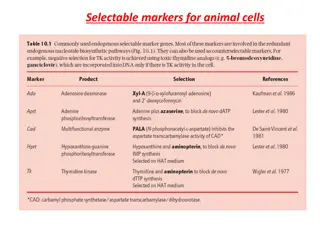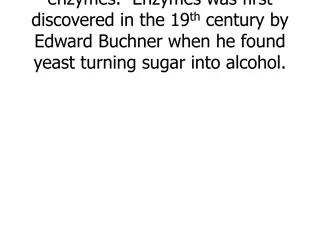Enzymes: Biological Catalysts in Living Cells
Enzymes are protein-based biological catalysts that play a vital role in catalyzing various reactions in the body. They are specific in action, required in small quantities, and sensitive to external factors. Enzymes mainly catalyze metabolic pathways, and their deficiency can lead to inborn errors of metabolism. Learn more about how enzymes function, their classification, and the factors that affect their activity.
Download Presentation

Please find below an Image/Link to download the presentation.
The content on the website is provided AS IS for your information and personal use only. It may not be sold, licensed, or shared on other websites without obtaining consent from the author.If you encounter any issues during the download, it is possible that the publisher has removed the file from their server.
You are allowed to download the files provided on this website for personal or commercial use, subject to the condition that they are used lawfully. All files are the property of their respective owners.
The content on the website is provided AS IS for your information and personal use only. It may not be sold, licensed, or shared on other websites without obtaining consent from the author.
E N D
Presentation Transcript
Enzymes 1
Enzymes are biological catalysts produced by the living cells and they catalyze several reactions in the body. They are protein in nature. They are specific in its action (i.e. each enzyme can catalyze only one type of reaction). They are required in very small quantities. The loss of catalytic activity was observed when they are subjected to heat or strong acids or bases or organic solvents. 2
The enzymes mainly catalyze the metabolic pathways in the body. The deficiency of the enzyme leads to inborn errors of metabolism. Most of the enzymes are produced by the cells of a particular tissue and function within that cell. Such en zymes are called intracellular enzymes (Example: enzymes of glycolysis, TCA cycle and fatty acid synthesis). 3
On the other hand there are certain enzymes, which are produced by the cells of a particular tissue from where these are liberated for use in the other tissues. Such enzymes are called extracellular enzymes. (Example: various proteolytic enzymes of gastrointestinal tract as Trypsin and Chymotrypsin). The enzyme binds with its specific substrate and forms an enzyme-substrate complex. At the end of the reaction the substrate is converted into the product and the enzymes remain unchanged. 4
In enzymatic reactions, the molecules at the beginning of the process, called substrates, are converted into different molecules, called products. Almost all chemical reactions in a biological cell need enzymes. 5
Like all catalysts, enzymes work by lowering the activation energy for a reaction, thus increasing the rate of the reaction. As a result, products are formed faster and reactions reach their equilibrium state more rapidly. Most enzyme reaction rates are millions of times faster than those of comparable un- catalyzed reactions. Enzymes are not consumed by the reactions they catalyze, nor do they alter the equilibrium of these reactions. Enzymes are known to catalyze about 4,000 biochemical reactions. 6
A few RNA molecules called ribozymes also catalyze reactions, with an important example being some parts of the ribosome. Enzyme activity can be affected by other molecules. 1. Inhibitors are molecules that decrease enzyme activity. 2. Activators are molecules that increase activity. 3. Many drugs and poisons are enzyme inhibitors. 4. Activity is also affected by temperature, chemical environment (e.g., pH), and the concentration of substrate. 7
Some enzymes are used commercially, for example, in the synthesis of antibiotics. Some household products use enzymes to speed up biochemical reactions: 1. Enzymes in biological washing powders break down protein or fat stains on clothes 2. Enzymes in meat tenderizers break down proteins into smaller molecules, making the meat easier to chew). 8
As early as the late 17th and early 18th centuries, the digestion of meat by stomach secretions and the conversion of starch to sugars by plant extracts and saliva were known. However, the mechanism by which this occurred had not been identified. In the 19th century, when studying the fermentation of sugar to alcohol by yeast, Louis Pasteur came to the conclusion that this fermentation was catalyzed by a vital force contained within the yeast cells called "ferments", which were thought to function only within living organisms. 11
In 1897, Eduard Buchner submitted his first paper on the ability of yeast extracts that lacked any living yeast cells to ferment sugar. In a series of experiments at the University of Berlin, he found that the sugar was fermented even when there were no living yeast cells in the mixture. He named the enzyme that brought about the fermentation of sucrose "zymase". In 1907, he received the Nobel Prize in Chemistry "for his biochemical research and his discovery of cell-free fermentation". Following Buchner's example, enzymes are usually named according to the reaction they carry out. Typically, to generate the name of an enzyme, the suffix -ase is added to the name of its substrate (e.g., lactase is the enzyme that cleaves lactose) or the type of reaction (e.g., DNA polymerase forms DNA polymers). 12
In 1926, James B. Sumner showed that the enzyme urease was a pure protein and crystallized it; Sumner did likewise for the enzyme catalase in 1937. Northrop and Stanley (1930), who worked on the digestive enzymes pepsin, trypsin and chymotrypsin. These three scientists were awarded the 1946 Nobel Prize in Chemistry. 13
Chemical Nature of Enzymes 14
Most enzymes are protein in nature. Some enzymes require the presence of certain additional organic or inorganic substances and are conjugated proteins. Such enzymes are called as holoenzymes. The protein part of the conjugated protein is called apoenzymes. The non-protein part is called prosthetic group. 15
Several apoenzymes require the presence of metal ions such as Mg2+ (as Hexokinase), Zn2+ (for the activity of carboxypeptidase). Such inorganic ions are called cofactors. If the metal ion is the integral part of the enzyme, such enzymes metalloenzymes. are called 17
Active Site 18
In biology, the active site is a small port in an enzyme where substrate molecules bind and undergo a chemical reaction. The active site is usually found in a 3-D groove or pocket of the enzyme, lined with amino acid residues. These residues are involved in recognition of the substrate. After an active site has been involved in a reaction, it can be used again. 19
Mechanism of enzyme action 20
Enzymes can act in several ways, all of which lower G (energy of activation). Lowering the activation energy by creating an environment in which the transition state is stabilized. Substrates need a lot of energy to reach a transition state, which then decays into products. The enzyme stabilizes the transition state, reducing the energy needed to form products. 21
1. Lock and key model Enzymes are very specific, and it was suggested by the Nobel laureate organic chemist Emil Fischer in 1894 that this was because both the enzyme and the substrate possess specific complementary geometric shapes that fit exactly into one another. This is often referred to as "the lock and key" model. However, while this model explains enzyme specificity, it fails to explain the stabilization of the transition state that enzymes achieve. 22
2. Induced fit The favored model for the enzyme-substrate interaction is the induced fit model. This model proposes that the initial interaction between enzyme and substrate is relatively weak, but that these weak interactions rapidly induce conformational changes in the enzyme that strengthen binding. 23
Michaelis constant Km As enzyme-catalysed reactions are saturable, their rate of catalysis does not show a linear response to increasing substrate. If the initial rate of the reaction is measured over a range of substrate concentrations (denoted as [S]), the reaction rate (v) increases as [S] increases. However, as [S] gets higher, the enzyme becomes saturated with substrate and the rate reaches Vmax, the enzyme's maximum rate. The Michaelis constant Kmis experimentally defined as the concentration at which the rate of the enzyme reaction is half Vmax. 25
Classification of Enzymes 27
Enzymes are classified into six groups according to the International Union of Biochemistry (IUB). They are: Oxidoreductases (EC1): Enzymes involved in oxidation-reduction reactions. E.g. Lactate dehydrogenase, Glyceraldehyde-3- phosphate dehydrogenase. Transferases(EC2): Enzymes transfer a particular group from one substrate to another. E.g. Alanine aminotransferase. Hydrolases(EC3): Hydrolyze the substrate with the addition of water molecule. E.g. Glucose 6-phosphatase, Amylase, Pepsin. 28
Lyases(EC4): Catalyze the removal of a small molecule from a large substrate without the addition of water. E.g. Fumarase and Enolase. Isomerases(EC5): They isomerize substrates. Ligases(EC6): Synthesize substances by joining two substrates with the utilization of energy. E.g. Glutamine synthetase. 29
EC number 30
The Enzyme Commission number (EC number) is a numerical classification scheme for enzymes, based on the chemical reactions they catalyze. As a system of enzyme nomenclature, every EC number is associated with a recommended name for the respective enzyme. Every enzyme code consists of the letters "EC" followed by four numbers separated by periods. Those numbers represent a progressively finer classification of the enzyme. 31
For example, the tripeptide aminopeptidases have the code "EC 3.4.11.4", whose components indicate the following groups of enzymes: EC 3 enzymes are hydrolases (enzymes that use water to break up some other molecule) EC 3.4 are hydrolases that act on peptide bonds EC 3.4.11 are those hydrolases that cleave off the amino-terminal amino acid from a polypeptide EC 3.4.11.4 are those that cleave off the amino- terminal end from a tripeptide 32
1. Stereospecificity: The group of enzyme catalyzes either L or D isomer. 2. Reaction Specificity: One enzyme catalyzes only one type of reaction. 3. Substrate Specificity: A. Absolute Specificity: Glucokinase acts on glucose only. B. Group Specificity: Hexokinase catalyzes hexoses. 34
4. Bond Specificity: Refers to the action of proteolytic enzymes, which act on peptide bonds of proteins. 5. Dual Specificity: There are two types of dual specificity: The enzyme act on two substrates by one reaction types. e.g. xanthine oxidase enzyme acts on xanthine and hypoxanthine (two substrates) by oxidation (one reaction type). The enzyme act on one substrate by two different reaction types. e.g. isocitrate dehydrogenase enzyme acts on isocitrate (one substrate) by oxidation followed by decarboxylation (two different reaction types) to produce -ketoglutrate as a reaction product. 35
1. Effect of pH: Each enzyme has an optimum pH at which the activity of the enzyme is maximum. Either decreased or increased pH causes a decrease in enzyme activity. Examples of optimum pH are: Pepsin has an optimum pH at (I-2). Optimum pH for amylase is (6.8). Optimum pH for ALP is (9.0). Optimum pH for ACP is (5.0). 37
2. Effect of Temperature: The temperature at which the enzyme activity is more is called optimum temperature. The enzyme activity was duplicated for every increase in temperature by 10 degrees till reaching to the maximum velocity for enzyme activity at the optimum temperature. After this point the enzyme activity decreases with the increment of temperature. At 100oC the enzyme will be denatured. While, at zero degree the enzyme will be kept inactivated and when the temperature increased the activity of enzyme will be increased. Optimum temperature of enzymes in the human body is 37oC. 39
3. Effect of Substrate Concentration: At low substrate concentration enzyme molecules are free initially and the ES complex (ES= enzyme-substrate) formation is proportional to the substrate concentration. At higher concentration all the enzyme molecules are saturated with substrate. There will be no change in the activity further. Hence in an enzyme reaction system more substrate is taken than the requirement. 41
4. Effect of Enzyme Concentration: The velocity of the enzyme reaction is directly proportional to the enzyme concentration. 5. Enzyme activators 6. Enzyme inhibitors 43
Enzyme inhibitors were classified into reversible and irreversible inhibitors I. Reversible inhibitors Reversible inhibitors bind to enzymes with non- covalent interactions (hydrogen bonds, hydrophobic interactions and ionic bonds). Multiple weak bonds between the inhibitor and the active site combine to produce strong and specific binding. Reversible inhibitors generally do not undergo chemical reactions when bound to the enzyme and can be easily removed by dilution or dialysis. 45
Classification of reversible inhibitors A. Competitive inhibition In competitive inhibition, the substrate and inhibitor cannot bind to the enzyme at the same time. This usually results from the inhibitor having an affinity for the active site of an enzyme where the substrate also binds. The substrate and inhibitor compete for access to the enzyme's active site. This type of inhibition can be overcome by sufficiently high concentrations of substrate (Vmax remains constant). Km will increase as it takes a higher concentration of the substrate to reach the Km point. Competitive inhibitors are often similar in structure to the real substrate. 46
Example: Malonate is a competitive inhibitor of succinate for succinate dehydrogenase 47
B. Non-competitive inhibition The binding of the inhibitor to the enzyme reduces its activity but does not affect the binding of substrate. The extent of inhibition depends only on the concentration of the inhibitor. Vmax will decrease due to the inability for the reaction to proceed as efficiently, Km will remain the same as the actual binding of the substrate will still function properly. 48
C. Uncompetitive inhibition In uncompetitive inhibition, the inhibitor binds only to the substrate-enzyme complex. This type of inhibition causes Vmax to decrease and Km to decrease. 49



